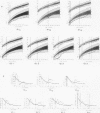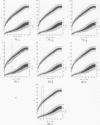Abstract
Growth was evaluated in a group of 10 infants and children with familial or idiopathic classic renal tubular acidosis in whom alkali therapy was initiated at ages ranging from 8 days to 9.5 yr and administered at dosage schedules documented to sustain correction of acidosis in at least four prolonged observation periods on the Pediatric Clinical Research Ward. When alkali therapy was begun, six patients (four infants and two children) were stunted (height <2.5 SD below mean). Of the four who were not, two infants were too young (<2 wk of age) to have become stunted, and two children had been documented earlier to be nonacidotic. At the start of alkali therapy, the heights of the patients correlated inversely with the maximal possible duration of prior acidosis.
With sustained alkali therapy: (a) each patient attained and maintained normal stature; (b) the mean height of the 10 patients increased from the 1.4±4 to the 37.0±33 percentile (of a normal age- and sex-matched population); (c) the mean height reached the 69th percentile in the eight patients whose heights could be analyzed according to parental prediction (Tanner technique); (d) the rate of growth increased two- to threefold, and normal heights were attained within 6 mo of initiating alkali therapy in the stunted infants and within 3 yr in the stunted children; (e) the height attained correlated inversely with the maximal possible duration of acidosis (before alkali therapy) only in those patients in whom alkali therapy was started after 6 mo of age, and not in those treated earlier.
The amount of alkali required to sustain correction of acidosis increased substantially during the course of treatment in each patient. The maximal alkali requirement ranged from 4.8 to 14.1 meq/kg per day, and in each patient its amount was determined principally by the magnitude of renal bicarbonate wasting.
Full text
PDF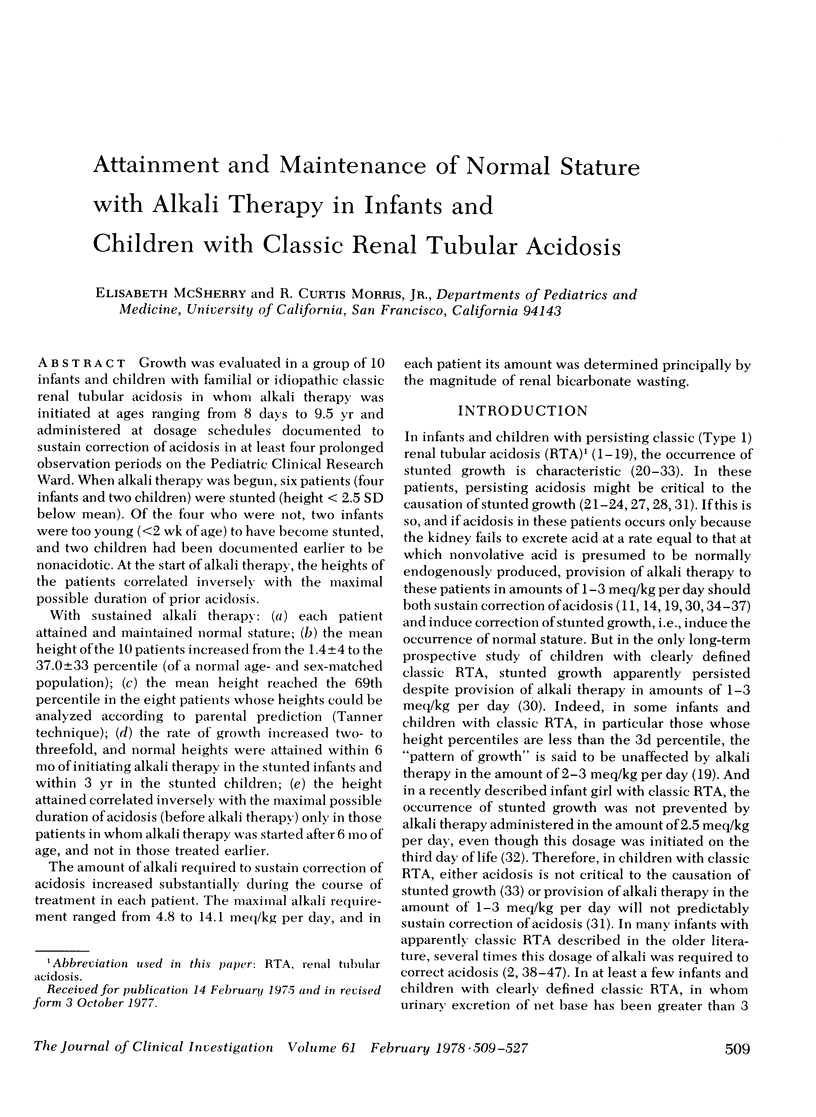
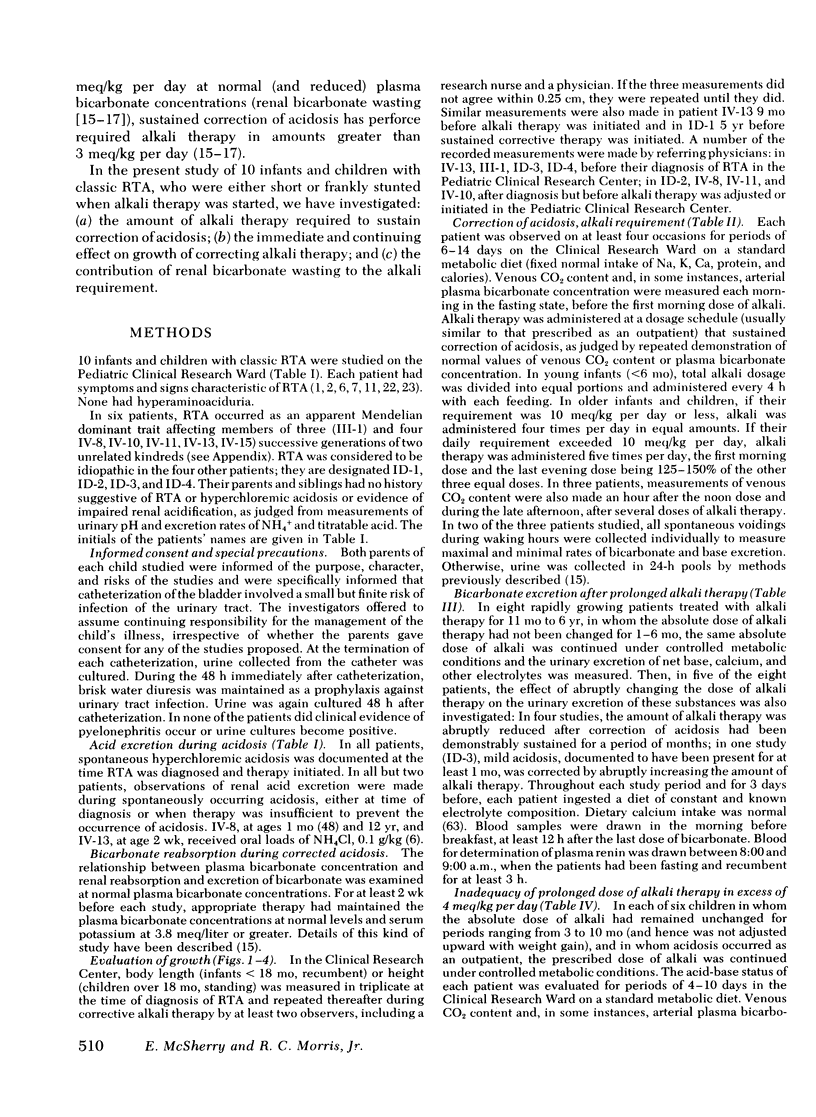
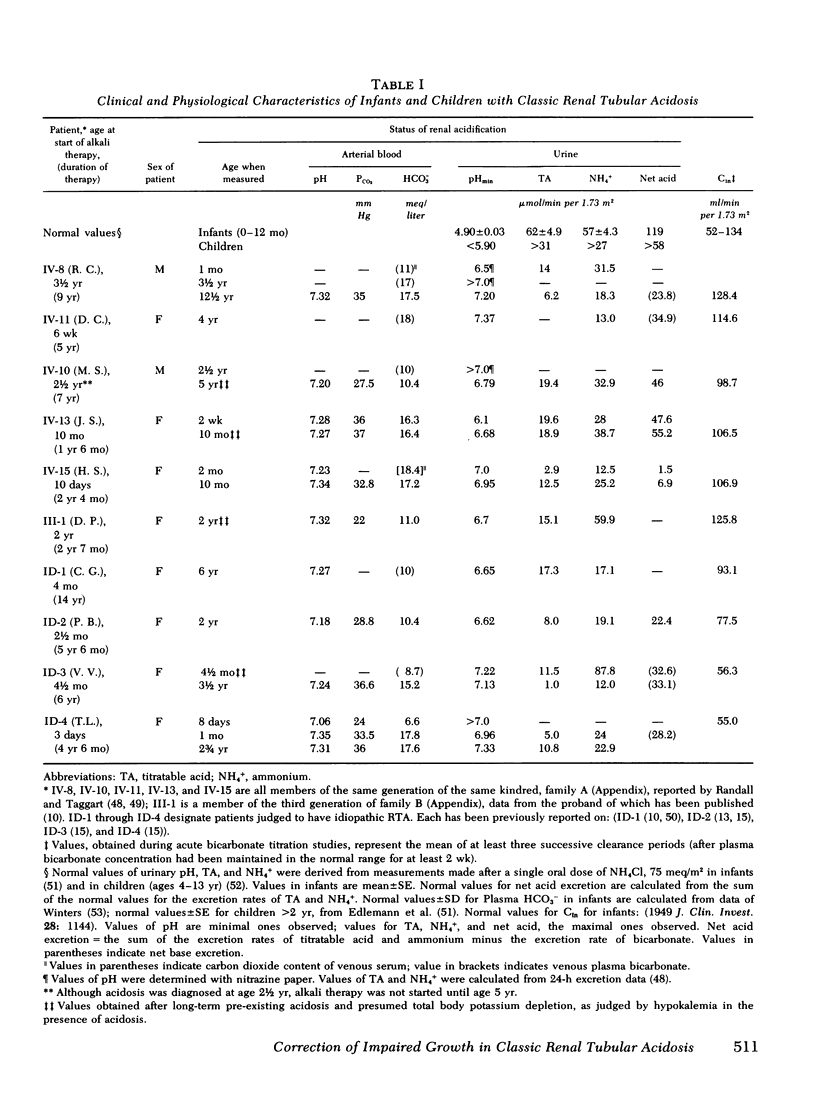
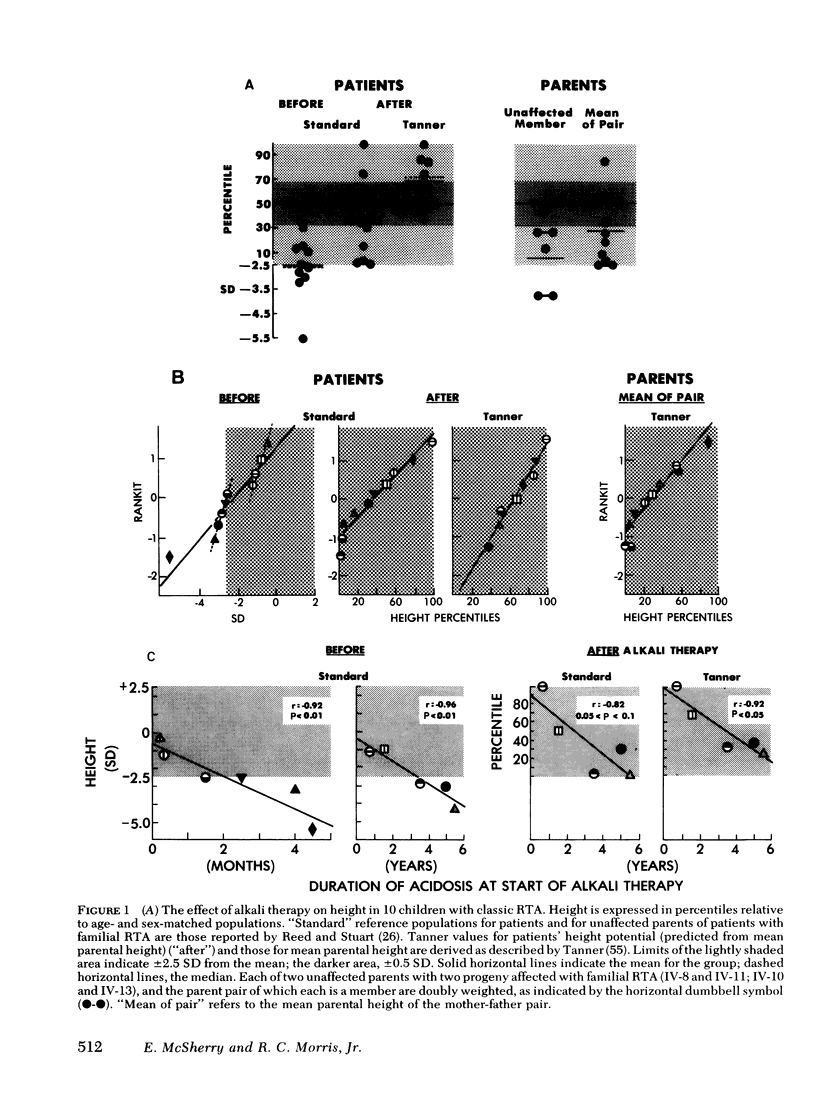
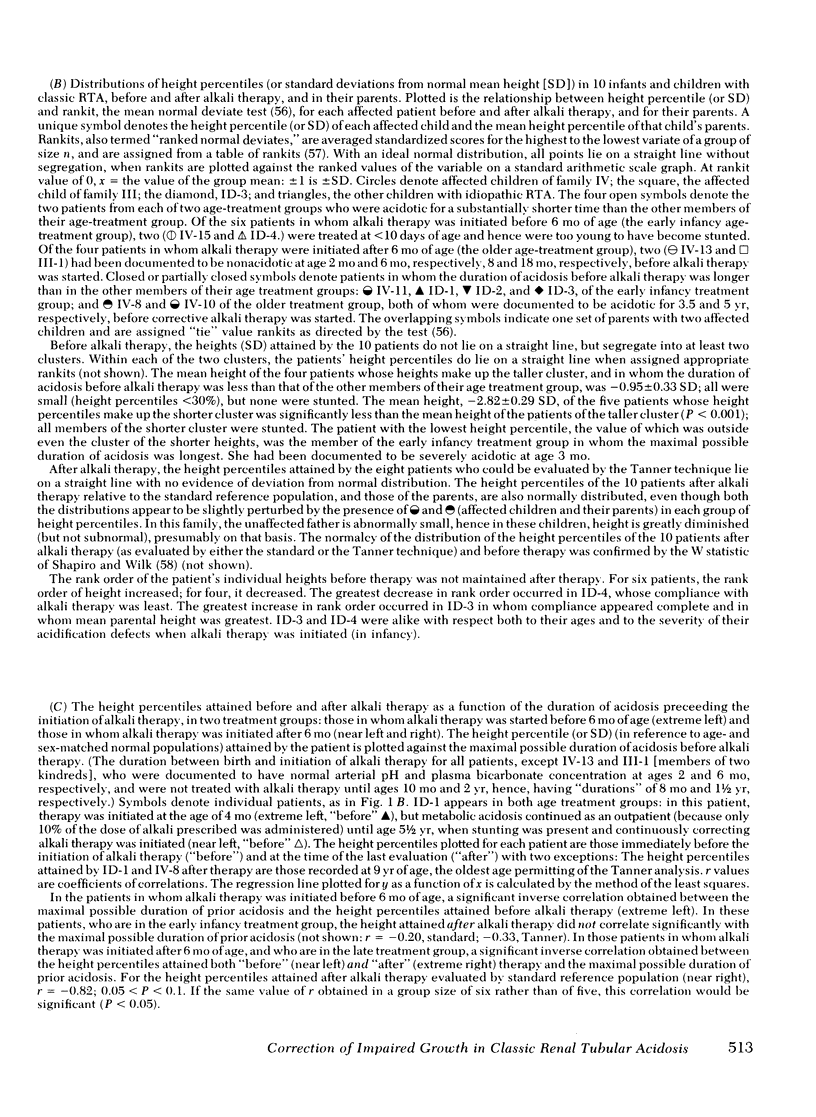
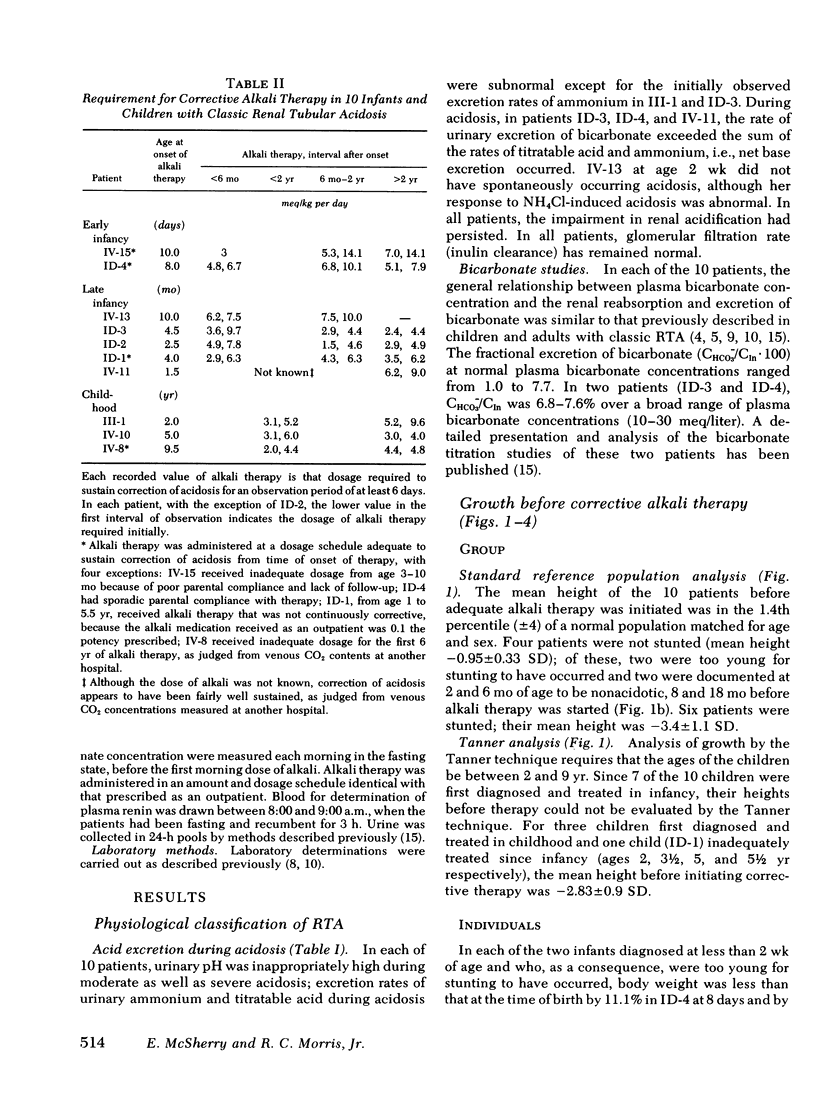
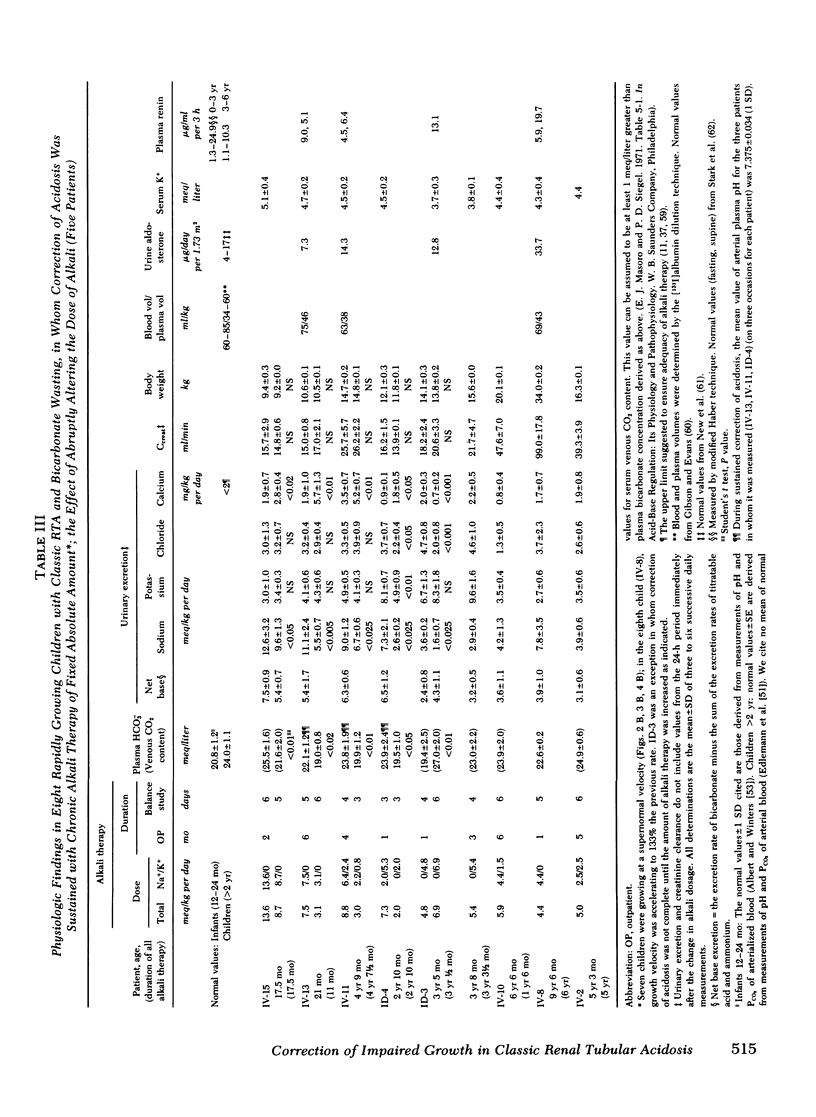
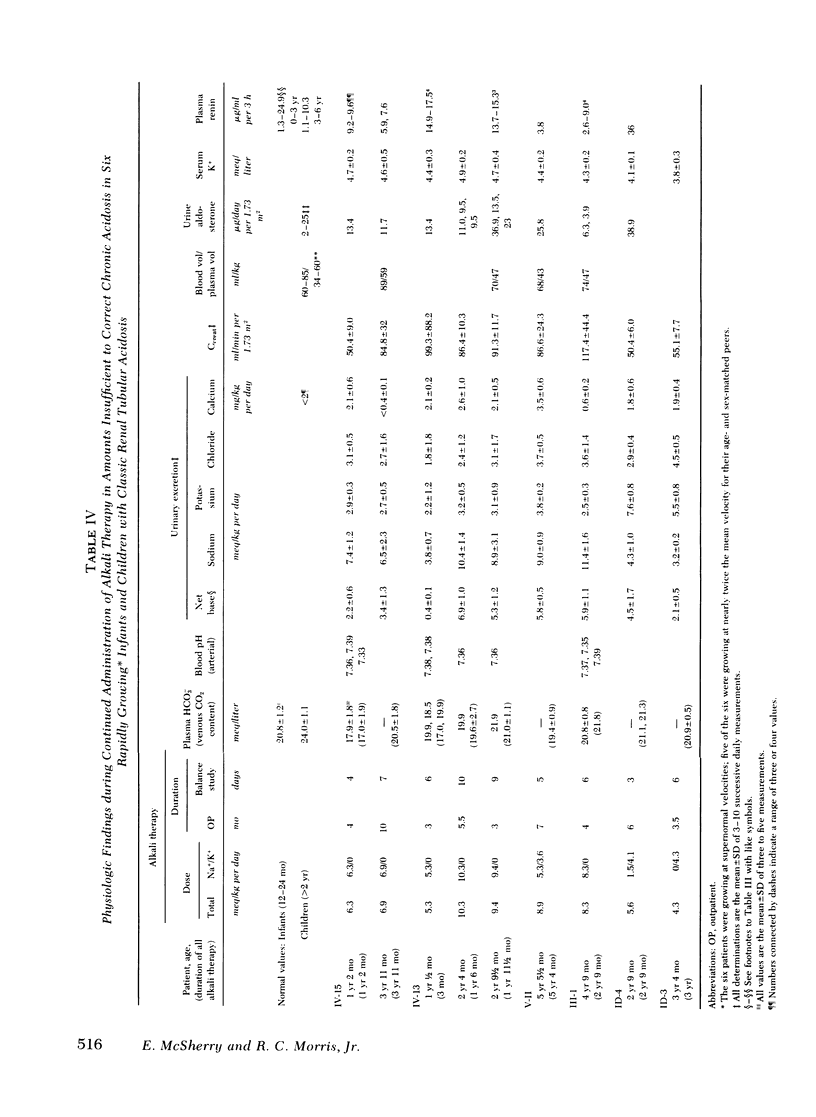

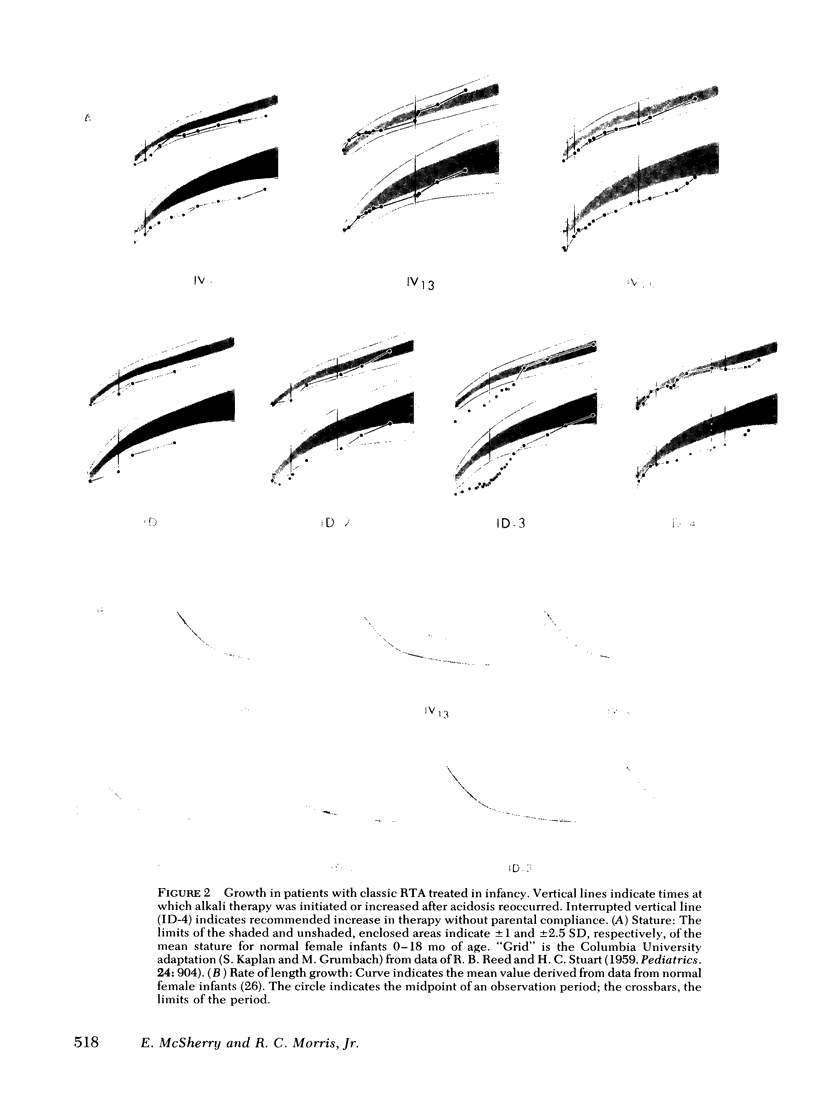
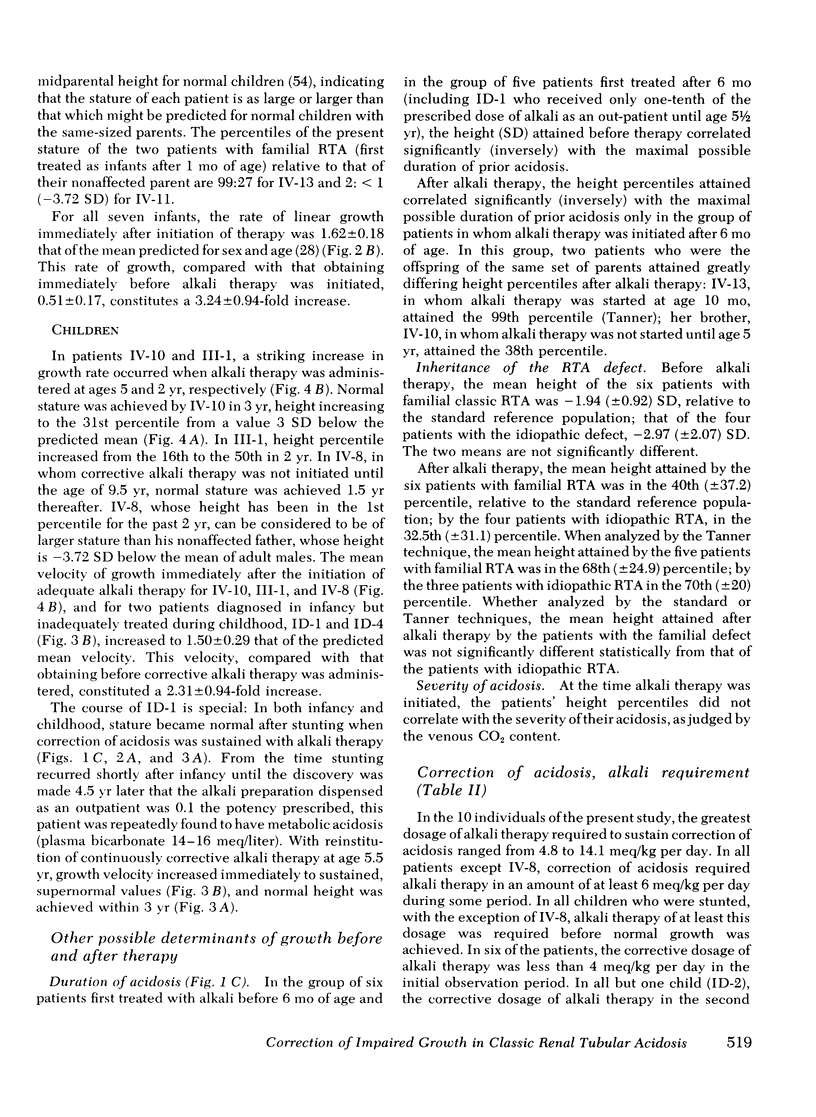
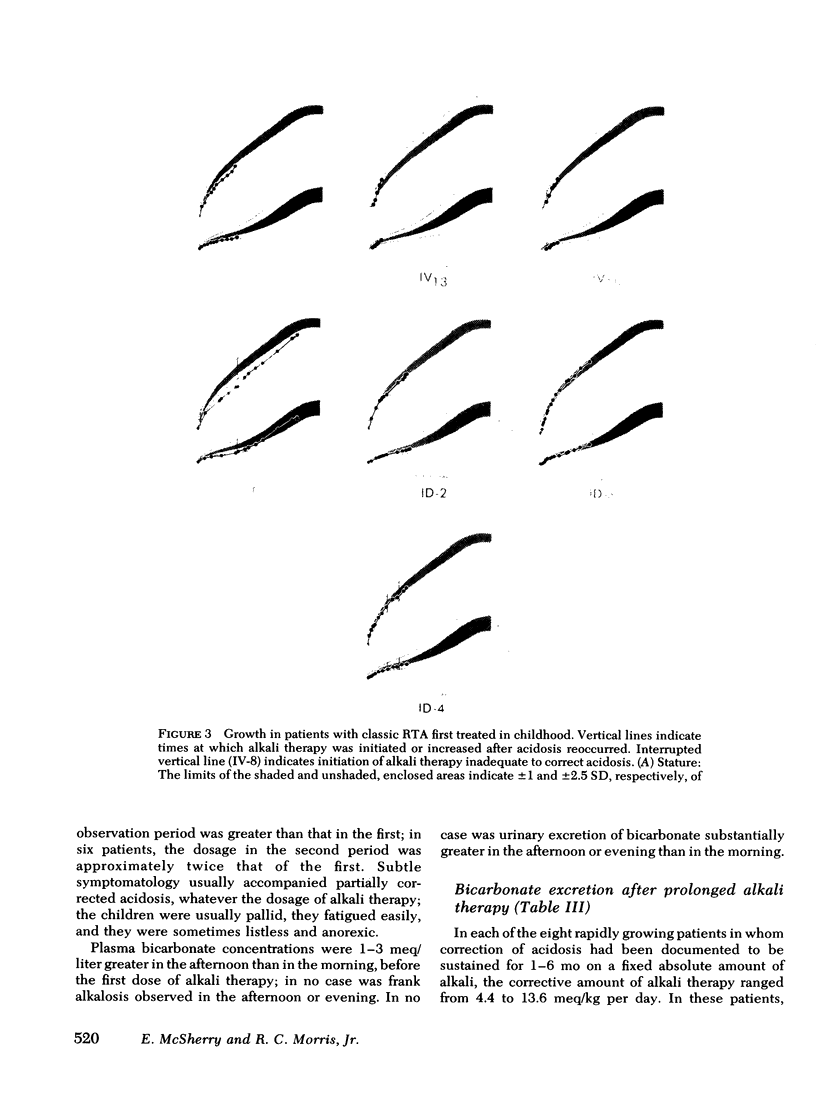


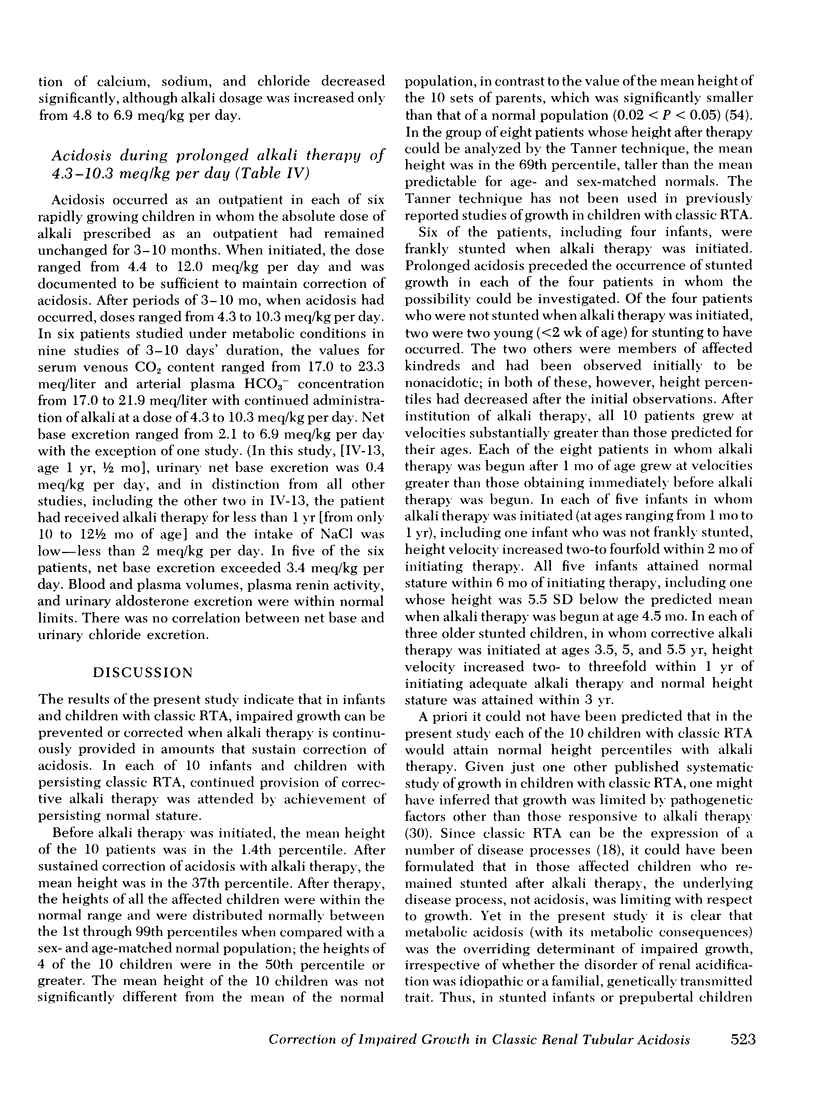
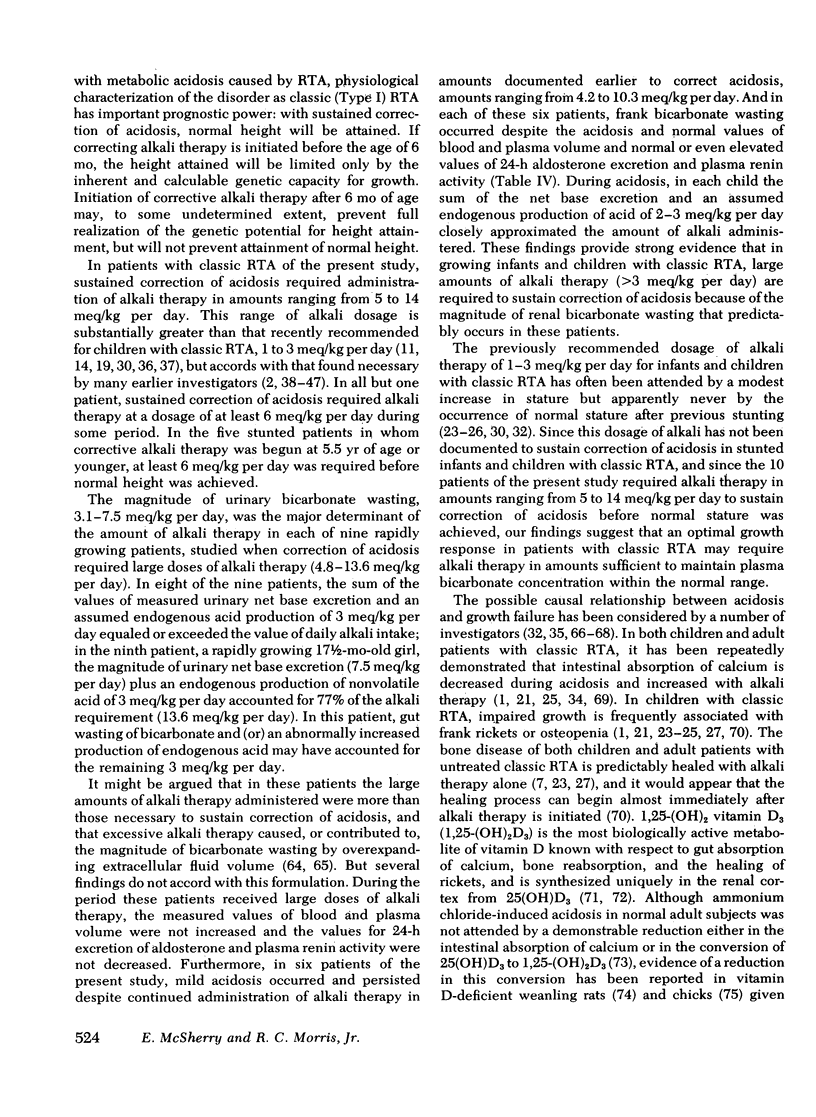
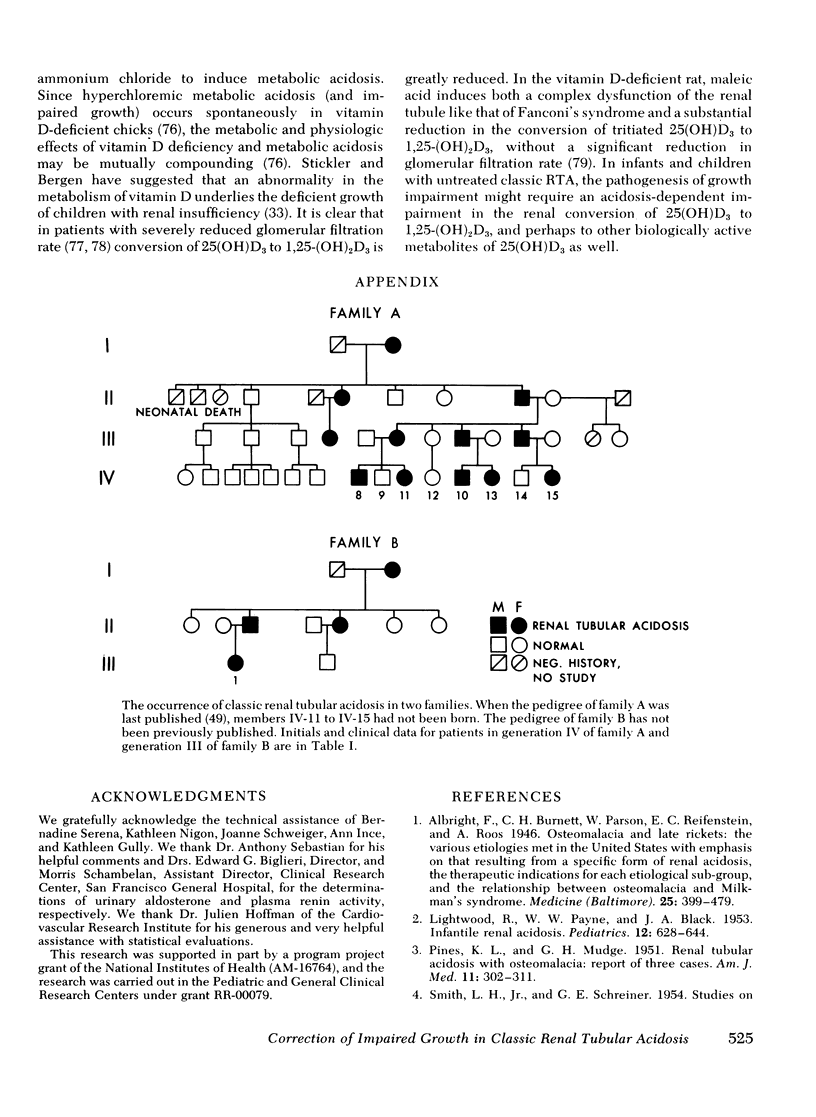
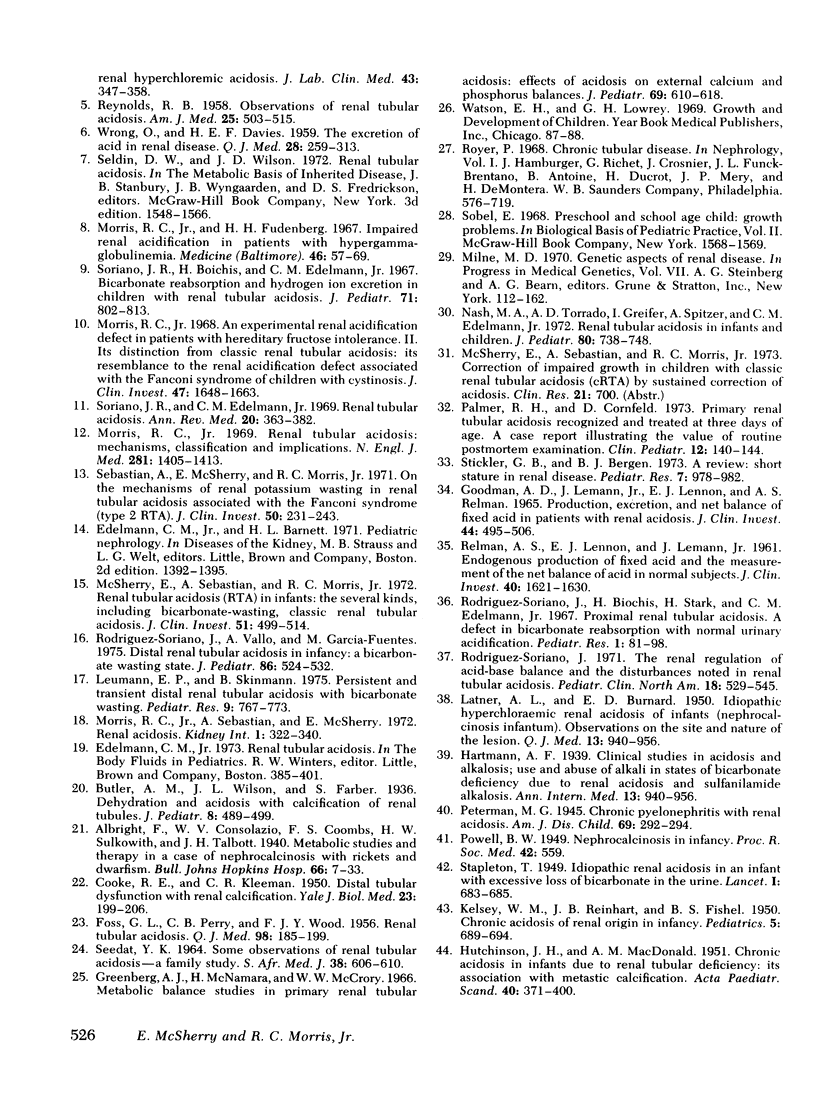
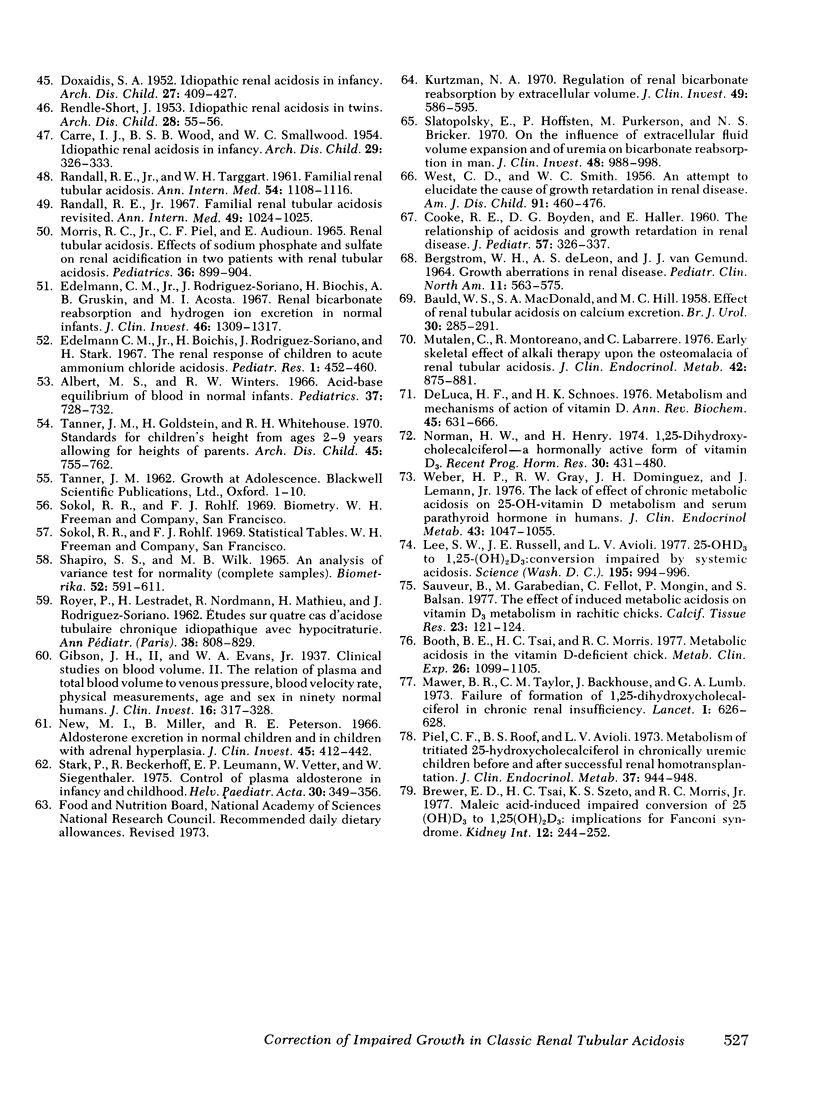
Images in this article
Selected References
These references are in PubMed. This may not be the complete list of references from this article.
- Albert M. S., Winters R. W. Acid-base equilibrium of blood in normal infants. Pediatrics. 1966 May;37(5):728–732. [PubMed] [Google Scholar]
- BAULD W. S., MACDONALD S. A., HILL M. C. Effect of renal tubular acidosis on calcium excretion. Br J Urol. 1958 Sep;30(3):285–291. doi: 10.1111/j.1464-410x.1958.tb03518.x. [DOI] [PubMed] [Google Scholar]
- BERGSTROM W. H., DELEON A. S., VANGEMUND J. J. GROWTH ABERRATIONS IN RENAL DISEASE. Pediatr Clin North Am. 1964 Aug;11:563–575. [PubMed] [Google Scholar]
- Booth B. E., Tsai H. C., Morris R. C., Jr Metabolic acidosis in the vitamin D-deficient chick. Metabolism. 1977 Oct;26(10):1099–1105. doi: 10.1016/0026-0495(77)90036-1. [DOI] [PubMed] [Google Scholar]
- Brewer E. D., Tsai H. C., Szeto K. S., Morris R. C., Jr Maleic acid-induced impaired conversion of 25(OH)D3 to 1,25(OH)2D3: implications for Fanconi's syndrome. Kidney Int. 1977 Oct;12(4):244–252. doi: 10.1038/ki.1977.109. [DOI] [PubMed] [Google Scholar]
- CARRE I. J., WOOD B. S., SMALLWOOD W. C. Idiopathic renal acidosis in infancy. Arch Dis Child. 1954 Aug;29(146):326–333. doi: 10.1136/adc.29.146.326. [DOI] [PMC free article] [PubMed] [Google Scholar]
- COOKE R. E., BOYDEN D. G., HALLER E. The relationship of acidosis and growth retardation. J Pediatr. 1960 Sep;57:326–337. doi: 10.1016/s0022-3476(60)80240-5. [DOI] [PubMed] [Google Scholar]
- COOKE R. E., KLEEMAN C. R. Distal tubular dysfunction with renal calcification. Yale J Biol Med. 1950 Dec;23(3):199–206. [PMC free article] [PubMed] [Google Scholar]
- DOXIADIS S. A. Idiopathic renal acidosis in infancy. Arch Dis Child. 1952 Oct;27(135):409–427. doi: 10.1136/adc.27.135.409. [DOI] [PMC free article] [PubMed] [Google Scholar]
- DeLuca H. F., Schnoes H. K. Metabolism and mechanism of action of vitamin D. Annu Rev Biochem. 1976;45:631–666. doi: 10.1146/annurev.bi.45.070176.003215. [DOI] [PubMed] [Google Scholar]
- Edelmann C. M., Jr, Boichis H., Soriano J. R., Stark H. The renal response of children to acute ammonium chloride acidosis. Pediatr Res. 1967 Nov;1(6):452–460. doi: 10.1203/00006450-196711000-00004. [DOI] [PubMed] [Google Scholar]
- Edelmann C. M., Soriano J. R., Boichis H., Gruskin A. B., Acosta M. I. Renal bicarbonate reabsorption and hydrogen ion excretion in normal infants. J Clin Invest. 1967 Aug;46(8):1309–1317. doi: 10.1172/JCI105623. [DOI] [PMC free article] [PubMed] [Google Scholar]
- FOSS G. L., PERRY C. B., WOOD F. J. Renal tubular acidosis. Q J Med. 1956 Apr;25(98):185–199. [PubMed] [Google Scholar]
- GOODMAN A. D., LEMANN J., Jr, LENNON E. J., RELMAN A. S. PRODUCTION, EXCRETION, AND NET BALANCE OF FIXED ACID IN PATIENTS WITH RENAL ACIDOSIS. J Clin Invest. 1965 Apr;44:495–506. doi: 10.1172/JCI105163. [DOI] [PMC free article] [PubMed] [Google Scholar]
- Gibson J. G., Evans W. A. CLINICAL STUDIES OF THE BLOOD VOLUME. II. THE RELATION OF PLASMA AND TOTAL BLOOD VOLUME TO VENOUS PRESSURE, BLOOD VELOCITY RATE, PHYSICAL MEASUREMENTS, AGE AND SEX IN NINETY NORMAL HUMANS. J Clin Invest. 1937 May;16(3):317–328. doi: 10.1172/JCI100860. [DOI] [PMC free article] [PubMed] [Google Scholar]
- Greenberg A. J., McNamara H., McCrory W. W. Metabolic balance studies in primary renal tubular acidosis: effects of acidosis on external calcium and phosphorus balances. J Pediatr. 1966 Oct;69(4):610–618. doi: 10.1016/s0022-3476(66)80048-3. [DOI] [PubMed] [Google Scholar]
- HUTCHISON J. H., MacDONALD A. M. Chronic acidosis in infants due to renal tubular deficiency: its association with metastatic calcification. Acta Paediatr. 1951 Sep;40(5):371–400. doi: 10.1111/j.1651-2227.1951.tb16504.x. [DOI] [PubMed] [Google Scholar]
- KELSEY W. M., REINHART J. B., FISHEL J. Chronic acidosis of renal origin in infancy. Pediatrics. 1950 Apr;5(4):689–694. [PubMed] [Google Scholar]
- Kurtzman N. A. Regulation of renal bicarbonate reabsorption by extracellular volume. J Clin Invest. 1970 Mar;49(3):586–595. doi: 10.1172/JCI106269. [DOI] [PMC free article] [PubMed] [Google Scholar]
- LIGHTWOOD R., PAYNE W. W., BLACK J. A. Infantile renal acidosis. Pediatrics. 1953 Dec;12(6):628–644. [PubMed] [Google Scholar]
- Lee S. W., Russell J., Avioli L. V. 25-hydroxycholecalciferol to 1,25-dihydroxycholecalciferol: conversion impaired by systemic metabolic acidosis. Science. 1977 Mar 11;195(4282):994–996. doi: 10.1126/science.841324. [DOI] [PubMed] [Google Scholar]
- Leumann E. P., Steinmann B. Persistent and transient distal renal tubular acidosis with bicarbonate wasting. Pediatr Res. 1975 Oct;9(10):767–773. doi: 10.1203/00006450-197510000-00004. [DOI] [PubMed] [Google Scholar]
- Mautalen C., Montoreano R., Labarrere C. Early skeletal effect of alkali therapy upon the osteomalacia of renal tubular acidosis. J Clin Endocrinol Metab. 1976 May;42(5):875–881. doi: 10.1210/jcem-42-5-875. [DOI] [PubMed] [Google Scholar]
- Mawer E. B., Taylor C. M., Backhouse J., Lumb G. A., Stanbury S. W. Failure of formation of 1,25-dihydroxycholecalciferol in chronic renal insufficiency. Lancet. 1973 Mar 24;1(7804):626–628. doi: 10.1016/s0140-6736(73)92197-1. [DOI] [PubMed] [Google Scholar]
- McSherry E., Sebastian A., Morris R. C., Jr Renal tubular acidosis in infants: the several kinds, including bicarbonate-wasting, classic renal tubular acidosis. J Clin Invest. 1972 Mar;51(3):499–514. doi: 10.1172/JCI106838. [DOI] [PMC free article] [PubMed] [Google Scholar]
- Morris R. C., Jr An experimental renal acidification defect in patients with hereditary fructose intolerance. II. Its distinction from classic renal tubular acidosis; its resemblance to the renal acidification defect associated with the Fanconi syndrome of children with cystinosis. J Clin Invest. 1968 Jul;47(7):1648–1663. doi: 10.1172/JCI105856. [DOI] [PMC free article] [PubMed] [Google Scholar]
- Morris R. C., Jr, Fudenberg H. H. Impaired renal acidification in patients with hypergammaglobulinemia. Medicine (Baltimore) 1967 Jan;46(1):57–69. doi: 10.1097/00005792-196701000-00003. [DOI] [PubMed] [Google Scholar]
- Morris R. C., Jr, McSherry E. Symposium on acid-base homeostasis. Renal acidosis. Kidney Int. 1972 May;1(5):322–340. doi: 10.1038/ki.1972.44. [DOI] [PubMed] [Google Scholar]
- Morris R. C., Jr Renal tubular acidosis. Mechanisms, classification and implications. N Engl J Med. 1969 Dec 18;281(25):1405–1413. doi: 10.1056/NEJM196912182812508. [DOI] [PubMed] [Google Scholar]
- Morris R. C., Piel C. F., Audioun E. Renal tubular acidosis. Effects of sodium phosphate and sulfate on renal acidification in two patients with renal tubular acidosis. Pediatrics. 1965 Dec;36(6):899–904. [PubMed] [Google Scholar]
- Nash M. A., Torrado A. D., Greifer I., Spitzer A., Edelmann C. M., Jr Renal tubular acidosis in infants and children. Clinical course, response to treatment, and prognosis. J Pediatr. 1972 May;80(5):738–748. doi: 10.1016/s0022-3476(72)80124-0. [DOI] [PubMed] [Google Scholar]
- New M. I., Miller B., Peterson R. E. Aldosterone excretion in normal children and in children with adrenal hyperplasia. J Clin Invest. 1966 Mar;45(3):412–428. doi: 10.1172/JCI105356. [DOI] [PMC free article] [PubMed] [Google Scholar]
- Norman A. W., Henry H. 1,25-Dihydroxycholecalciferol--a hormonally active form of vitamin D. Recent Prog Horm Res. 1974;30(0):431–480. [PubMed] [Google Scholar]
- PINES K. L., MUDGE G. H. Renal tubular acidosis with osteomalacia; report of 3 cases. Am J Med. 1951 Sep;11(3):302–311. doi: 10.1016/0002-9343(51)90167-2. [DOI] [PubMed] [Google Scholar]
- Palmer R. H., Cornfeld D. Primary renal tubular acidosis recognized and treated at three days of age. A case report illustrating the value of routine postmortem examination. Clin Pediatr (Phila) 1973 Mar;12(3):140–144. doi: 10.1177/000992287301200307. [DOI] [PubMed] [Google Scholar]
- Piel C. F., Roof B. S., Avioli L. V. Metabolism of tritiated 25-hydroxycholecalciferol in chronically uremic children before and after successful renal homotransplantation. J Clin Endocrinol Metab. 1973 Dec;37(6):944–948. doi: 10.1210/jcem-37-6-944. [DOI] [PubMed] [Google Scholar]
- RANDALL R. E., Jr, TARGGART W. H. Familial renal tubular acidosis. Ann Intern Med. 1961 Jun;54:1108–1116. doi: 10.7326/0003-4819-54-6-1108. [DOI] [PubMed] [Google Scholar]
- RELMAN A. S., LENNON E. J., LEMANN J., Jr Endogenous production of fixed acid and the measurement of the net balance of acid in normal subjects. J Clin Invest. 1961 Sep;40:1621–1630. doi: 10.1172/JCI104384. [DOI] [PMC free article] [PubMed] [Google Scholar]
- RENDLE-SHORT J. Idiopathic renal acidosis in twins; alkalosis resulting from overdosage of a citrate mixture. Arch Dis Child. 1953 Feb;28(137):55–56. doi: 10.1136/adc.28.137.55. [DOI] [PMC free article] [PubMed] [Google Scholar]
- REYNOLDS T. B. Observations on the pathogenesis of renal tubular acidosis. Am J Med. 1958 Oct;25(4):503–515. doi: 10.1016/0002-9343(58)90040-8. [DOI] [PubMed] [Google Scholar]
- Randall R. E., Jr Familial renal tubular acidosis revisited. Ann Intern Med. 1967 May;66(5):1024–1025. doi: 10.7326/0003-4819-66-5-1024_2. [DOI] [PubMed] [Google Scholar]
- Rodriguez Soriano J., Boichis H., Stark H., Edelmann C. M., Jr Proximal renal tubular acidosis. A defect in bicarbonate reabsorption with normal urinary acidification. Pediatr Res. 1967 Mar;1(2):81–98. doi: 10.1203/00006450-196703000-00001. [DOI] [PubMed] [Google Scholar]
- Rodriguez-Soriano J., Edelmann C. M., Jr Renal tubular acidosis. Annu Rev Med. 1969;20:363–382. doi: 10.1146/annurev.me.20.020169.002051. [DOI] [PubMed] [Google Scholar]
- Rodriguez-Soriano J. The renal regulation of acid-base balance and the disturbances noted in renal tubular acidosis. Pediatr Clin North Am. 1971 May;18(2):529–545. doi: 10.1016/s0031-3955(16)32564-0. [DOI] [PubMed] [Google Scholar]
- Rodriguez-Soriano J., Vallo A., Garcia-Fuentes M. Distal renal tubular acidosis in infancy: a bicarbonate wasting state. J Pediatr. 1975 Apr;86(4):524–532. doi: 10.1016/s0022-3476(75)80141-7. [DOI] [PubMed] [Google Scholar]
- SEEDAT Y. K. SOME OBSERVATIONS OF RENAL TUBULAR ACIDOSIS--A FAMILY STUDY. S Afr Med J. 1964 Aug 15;38:606–610. [PubMed] [Google Scholar]
- SMITH L. H., Jr, SCHREINER G. E. Studies on renal hyperchloremic acidosis. J Lab Clin Med. 1954 Mar;43(3):347–358. [PubMed] [Google Scholar]
- Sauveur B., Garabedian M., Fellot C., Mongin P., Balsan S. The effect of induced metabolic acidosis on vitamin D3 metabolism in rachitic chicks. Calcif Tissue Res. 1977 Jun 28;23(2):121–124. doi: 10.1007/BF02012776. [DOI] [PubMed] [Google Scholar]
- Sebastian A., McSherry E., Morris R. C., Jr On the mechanism of renal potassium wasting in renal tubular acidosis associated with the Fanconi syndrome (type 2 RTA). J Clin Invest. 1971 Jan;50(1):231–243. doi: 10.1172/JCI106479. [DOI] [PMC free article] [PubMed] [Google Scholar]
- Slatopolsky E., Hoffsten P., Purkerson M., Bricker N. S. On the influence of extracellular fluid volume expansion and of uremia on bicarbonate reabsorption in man. J Clin Invest. 1970 May;49(5):988–998. doi: 10.1172/JCI106318. [DOI] [PMC free article] [PubMed] [Google Scholar]
- Soriano J. R., Boichis H., Edelmann C. M., Jr Bicarbonate reabsorption and hydrogen ion excretion in children with renal tubular acidosis. J Pediatr. 1967 Dec;71(6):802–813. doi: 10.1016/s0022-3476(67)80005-2. [DOI] [PubMed] [Google Scholar]
- Stark P., Beckerhoff R., Leumann E. P., Vetter W., Siegenthaler W. Control of plasma aldosterone in infancy and childhood. A study of plasma renin activity, plasma cortisol and plasma aldosterone. Helv Paediatr Acta. 1976 Jan;30(4-5):349–356. [PubMed] [Google Scholar]
- Stickler G. B., Bergen B. J. A review: short stature in renal disease. Pediatr Res. 1973 Dec;7(12):978–982. doi: 10.1203/00006450-197312000-00006. [DOI] [PubMed] [Google Scholar]
- Tanner J. M., Goldstein H., Whitehouse R. H. Standards for children's height at ages 2-9 years allowing for heights of parents. Arch Dis Child. 1970 Dec;45(244):755–762. doi: 10.1136/adc.45.244.755. [DOI] [PMC free article] [PubMed] [Google Scholar]
- WEST C. D., SMITH W. C. An attempt to elucidate the cause of growth retardation in renal disease. AMA J Dis Child. 1956 May;91(5):460–476. doi: 10.1001/archpedi.1956.02060020462008. [DOI] [PubMed] [Google Scholar]
- WRONG O., DAVIES H. E. The excretion of acid in renal disease. Q J Med. 1959 Apr;28(110):259–313. [PubMed] [Google Scholar]
- Weber H. P., Gray R. W., Dominguez J. H., Lemann J., Jr The lack of effect of chronic metabolic acidosis on 25-OH-vitamin D metabolism and serum parathyroid hormone in humans. J Clin Endocrinol Metab. 1976 Nov;43(5):1047–1055. doi: 10.1210/jcem-43-5-1047. [DOI] [PubMed] [Google Scholar]



